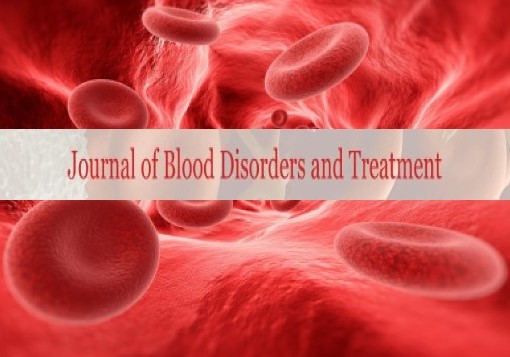Acute promyelocytic leukemia
Received: 04-Sep-2022, Manuscript No. puljbdt-23-6214; Editor assigned: 06-Sep-2022, Pre QC No. puljbdt-23-6214 (PQ); Accepted Date: Sep 20, 2022; Reviewed: 10-Sep-2022 QC No. puljbdt-23-6214 (Q); Revised: 12-Sep-2022, Manuscript No. puljbdt-23-6214 (R); Published: 30-Sep-2022, DOI: 10.37532/puljbdt.2022.5(5).04
Citation: Collins A. Acute promyelocytic Leukemia. J. Blood Disord Treat.2022; 5(5):04.
This open-access article is distributed under the terms of the Creative Commons Attribution Non-Commercial License (CC BY-NC) (http://creativecommons.org/licenses/by-nc/4.0/), which permits reuse, distribution and reproduction of the article, provided that the original work is properly cited and the reuse is restricted to noncommercial purposes. For commercial reuse, contact reprints@pulsus.com
Abstract
Acute myeloid leukaemia, a malignancy of the blood-forming tissue, includes acute promyelocytic leukaemia as a subtype (bone marrow). Hematopoietic stem cells produce white blood cells (leukocytes), which guard the body against infection, platelets (thrombocytes), which are involved in blood clotting, and red blood cells (erythrocytes), which transport oxygen.
Keywords
Leukocytes; Thrombocytes; Erythrocytes
Introduction
Promyelocytes, juvenile white blood cells, build up in the bone marrow in acute promyelocytic leukemia. Many of the signs and symptoms of the condition are brought on by the overproduction of promyelocytes, which creates a deficiency of healthy white, red, and platelet blood cells in the body. Promyelocytes, juvenile white blood cells, build up in the bone marrow in acute promyelocytic leukaemia. Many of the signs and symptoms of the condition are brought on by the overproduction of promyelocytes, which creates a deficiency of healthy white, red, and platelet blood cells in the body. Blood in the pee (hematuria), nose bleeds, bleeding from the gums, excessive menstrual bleeding, and tiny red dots under the skin (petechiae) are all more common in people with acute promyelocytic leukemia. Both the cancerous cells release of chemicals that cause excessive bleeding as well as the low platelet count in the blood (thrombocytopenia), which contributes to the abnormal bleeding and bruising, are to blame.
Anemia, or having insufficient red blood cells, can result in pallor (pale skin), which is a symptom of acute promyelocytic leukaemia, or excessive exhaustion (fatigue). Additionally, because normal white blood cells that fight infection are lost in those who are affected, they may recover from wounds slowly or experience recurrent infections. In addition, leukemic cells have the potential to spread to the bones and joints, where they may produce discomfort. Fever, appetite loss, and weight loss are just a few examples of general indications and symptoms that could appear. AML, a blood cancer that affects the bone marrow, has a form known as APL. Stem cells, which are cells that can differentiate into different kinds of cells, are found in bone marrow. Blood cells are created from stem cells in the bone marrow. A mutation in a person's DNA causes APL. Information that an individual inherits from their parents is stored in genes. Some genomes contain instructions for making particular proteins. Chromosomes, which are substantial lines of DNA that house a person's genes, are found in all of the body's cells. The RARA gene on chromosome 17 and the PML gene on chromosome 15 switch places when an individual has APL. Translocation is the term for this action. Part of the PML gene and portion of the RARA gene fuse during translocation. The protein PML-RAR is made from this combined gene. The PML gene typically creates a protein that inhibits excessive cell division or growth.
However, both of these proteins activities are disrupted by the PMLRAR protein. Because of this, the promyelocytes proliferate quickly and are unable to develop into white blood cells. The accumulation of promyelocytes in the bone marrow interferes with the generation of healthy white blood cells. Different than other forms of AML, APL requires a distinct course of treatment. Promyelocytes are killed by conventional chemotherapy medications, which cause them to produce proteins that result in uncontrollable bleeding and blood clotting. A person may experience haemorrhage or clotting issues as a result, which could be fatal. A distinct variant of Acute Myeloid Leukaemia (AML) is Acute Promyelocytic Leukaemia (APL).The outlook for APL is improving; whereas previously it was the worst among AML, it is now the best. By utilising All-Trans-Retinoic Acid (ATRA) in the induction therapy for APL, the response rate is markedly increased while the mortality of freshly diagnosed patients is reduced. As a result, ATRA in combination with chemotherapy based on anthracyclines is a commonly used and accepted therapy. High doses of cytarabine have been shown to be effective in preventing relapse in high-risk individuals. We find that the regimen of ATRA combined with ATO seems to be a new treatment option because of their targeting mechanisms, milder toxicities, and improvements of long-term outcomes; this combination may become a potentially curable treatment modality for APL as the indications of Arsenic Trioxide (ATO) for APL are being extended from the original relapse treatment to the first-line treatment of de novo APL.





